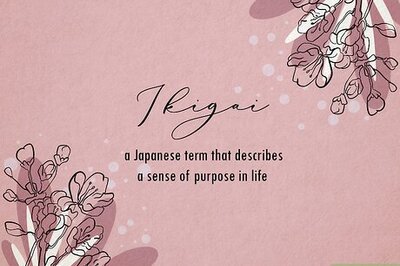
views
Healthy Fats for a Keto Diet
Monounsaturated fat Monounsaturated fat is a healthy fat integral to the keto diet. Scientifically, monounsaturated fats are fat molecules with one unsaturated carbon bond. Beyond that, monounsaturated fat is proven to aid heart health and weight management and lower bad cholesterol levels in your blood. Monounsaturated fats can be found in foods and oils such as: Avocados Peanut butter Some nuts and seeds Olive oil Canola oil Peanut oil Sesame oil Safflower oil
Polyunsaturated fat Polyunsaturated fats are fat molecules with more than one unsaturated carbon bond. Like monounsaturated fat, it’s considered a healthy fat (when consumed in moderation) and can help reduce the risk of heart disease and stroke, among other ailments. Foods and oils with polyunsaturated fat include: Fatty fish Some nuts and seeds Tofu and soybeans Canola, corn, soybean, and sunflower oil There are two categories of polyunsaturated fat: Omega-6s and Omega-3s. Both should be included in your diet, but some Omega-6 vegetable oils are used to make unhealthy deep-fried foods—so it may be a good idea to limit some vegetable oils (like peanut, sunflower, and soybean).
Saturated fat Saturated fat is fat molecules that have been “saturated” with hydrogen bonds. Saturated fat is somewhat controversial; overconsuming it was linked with heart disease, but some studies in recent years have suggested this may not be the case (though American health organizations still recommend limiting saturated fats in your diet). So, in terms of the keto diet, eating saturated fats in moderation is the key. This includes: Cheese Milk and butter Dairy desserts Meats
How to Get More Fat on a Keto Diet
Eat plenty of whole eggs. Eggs are nutritious and contain healthy fats, so they’re ideal for a Keto diet! Just aim to eat the whole egg (rather than just part) since the yolks contain vitamin B and antioxidants that aid eye health. According to the USDA, one egg contains roughly 5 grams of fat, 7 grams of protein, and 80 calories. How to use eggs: Hard-boil a carton of eggs and use them as snacks Make an egg scramble with low-carb vegetables Make egg salad (with mayonnaise) Make poached eggs with avocado (another source of healthy fat)
Pick out fatty cuts of meat and fish. Fatty fish (including anchovies, salmon, tuna, sardines, and mackerel) contain plenty of omega-3 fats and protein to boost your heart health. Salmon also contains vitamin D, which is great for your immune system and bone health. When you opt for fatty meats (like ribeye, pork belly, and lamb chops), opt for fresh and grass-fed rather than processed meat. How to use fish and meats: Bake or grill your fish, then serve it with roasted veggies or a salad Add canned fish to mayonnaise, herbs, and spices to use as a dip, or add to a lettuce wrap Fatty meats can be a main course; just remember to eat them in moderation
Spike hot drinks and smoothies with fat. All you need is one tablespoon of fat (using butter, coconut cream, coconut oil, heavy cream, or MCT oil, which is odorless and tasteless). Add your fat of choice to coffee or tea to get a little extra fat intake with your drink. You can stir it in or mix the drink in a blender to get the job done!
Use avocado in different dishes and snacks. Avocados are perfect for the keto diet, containing healthy unsaturated fat, fiber, vitamins, and minerals; research shows they may also aid your heart health and lead to balanced blood sugars. So, find creative ways to add avocado (or avocado oil) to your diet. How to use avocado: Eat avocado by itself if you enjoy it Make guacamole Add avocado to smoothies and salads Drizzle avocado oil on cooked vegetables Add avocado oil to salad dressing (and other sauces, if desired)
Get nuts and seeds to eat when you need a snack. Nuts and seeds are definitely your friends on a keto diet, especially flax seeds, chia seeds, hemp seeds, pumpkin seeds, pistachios, walnuts, almonds, pecans, cashews, and Brazil nuts. For example, flax and chia seeds are excellent omega-3 fats and fiber sources, while hemp seeds contain all essential amino acids, vitamin E, calcium, iron, and potassium. How to use nuts and seeds: Make a snack of mixed nuts and seeds Sprinkle nuts on your salad or soup Put flax, chia, or hemp seeds into smoothies, soups, yogurts, and salads Use chia seeds as a keto breading for baked fish or meat (like chicken and pork) Soak chia seeds in water to make chia pudding Add ground or whole flax seeds to baked goods like muffins, pancakes, and crackers Add hemp seeds to energy bites, sauces, and dressings
Incorporate nut and seed butter into your food. Nut and seed butters are just another way to get the nutrients (and fat) you’d get from plain old nuts and seeds! There are plenty of butters to choose from; you can use peanut butter, almond butter, or sunflower butter, to name a few. Just read the label when buying nut butter to ensure there aren’t any added sweeteners. How to use nut and seed butter: Put sunflower butter on keto crackers Dip vegetables in almond butter Add your nut butter of choice to a smoothie Use nut butter in sauces or marinades to put on fish
Eat full-fat sour cream, Greek yogurt, and cheese. Sour cream, Greek yogurt, and cheese are all examples of low-carb, high-fat foods, making them ideal for the keto diet. Just make sure you’re picking the full-fat option (since you can get many of these items in low-fat or fat-free forms, too). Yogurt, in particular, is also a source of probiotics, which aid digestive functioning. How to use sour cream, cheese, and Greek yogurt: Make a Greek yogurt parfait with nuts, seeds, and cacao, or combine it with your favorite herbs and spices to make vegetable dip Have a snack of cheese and vegetable sticks, melt it over cooked veggies, or add shredded cheese to salad or grilled meat Add sour cream to roasted veggies or mix it into smoothies or soups
Add mayo to dressings and dips. Mayonnaise is another keto-friendly condiment, especially because it’s made with whole eggs. However, to make sure you’re getting the healthiest option possible, it’s recommended you either make homemade mayo or buy a brand with no added sugars and preservatives. Plus, you can use healthy oils (like olive or avocado) to make homemade mayonnaise! How to use mayonnaise: Add mayo to salad dressings Combine mayo with herbs and spices to make a vegetable dip Put mayo on lettuce wraps
Eat olives as a snack and use olive oil in dishes. Olives contain heart-healthy fat, vitamin E, and compounds proven to reduce the risk of heart disease, cancer, and osteoporosis. What’s not to love? So, if you need more fat in your diet, look for ways to incorporate olives—and olive oil—into it. How to use olives: Eat them as a snack (which you can also easily bring on the go) Toss olives in salads or add them to charcuterie boards Stuff olives with gorgonzola cheese or garlic and pimentos Make tapenade with olives, olive oil, anchovies, and capers Drizzle cold-pressed extra virgin olive oil over cooked veggies Use olive oil as a salad dressing or the base for a marinade
Enjoy cacao nibs in your trail mix or drinks. Who says you can’t have chocolate while on a diet? Cacao nibs are basically raw, unsweetened, and unprocessed chocolate; they contain both fat and fiber, as well as polyphenols (compounds that can promote healthy gut bacteria). So, if you’re on the keto diet and in the mood for chocolate, opt for cacao nibs. How to use cacao nibs: Add cacao nibs to smoothies and trail mix Snack on plain cacao nibs Make hot chocolate with cacao nibs, unsweetened coconut milk, and a keto sweetener like stevia
Sprinkle coconut flakes on meats, veggies, and other dishes. Coconuts naturally contain medium-chain triglycerides (MCTs), an easy-to-absorb fat type that may even make it easier to transition into ketosis during the keto diet. So, coconut (and coconut oil) are fantastic additions to your keto-friendly meals. How to use coconut and coconut oil: Mix ground or finely-chopped unsweetened coconut flakes, almonds, sunflower seeds, sesame seeds, chia seeds, and lime zest to make a seasoning for meats and veggies Put unsweetened coconut flakes in your smoothies or trail mix Make curried meats with full-fat coconut milk Roast your vegetables in coconut oil Make sautéed cauliflower rice using coconut oil and lime
Cook vegetables in butter. Did you know that butter is a solid addition to a keto diet? It’s carb-free and high in fat while also being a good source of butyrate (a fat that may promote brain health). When possible, opt for high-quality butter, ideally organic from grass-fed cows. How to use butter: As mentioned above, roast or sauté veggies using butter Spread butter on keto-friendly pancakes, waffles, and muffins Get crispy chicken skin by rubbing butter on it before roasting it
Whip up some fat bombs. Fat bombs are basically tasty little balls made from a high-fat base, a binding agent, other ingredients (like cacao nibs or nuts) for flavor, and natural or zero-calorie sweeteners (like monk fruit or Stevia). They can be an excellent dessert substitute while on the keto diet, and they’re super customizable—so you can make them according to your personal tastes. For example, you can make fat bombs using almond butter, pecans and almonds, chia seeds, unsweetened almond or coconut milk (to bind everything together) and your choice of a sweetener! All you have to do is blend your ingredients together until the mixture becomes dough-like, chill it, then scoop it into individual balls.
Fats to Avoid on a Keto Diet
Trans fat Trans fat is notoriously unhealthy, and consuming it has been linked to numerous health conditions, including heart disease and cancer. Trans fats often come from hydrogenation—the process of turning oils into solids to stop them from going bad. Manufacturers used to add trans fats to processed foods before the FDA banned the practice in 2018. Artificial trans fats have been banned, but you may still find small amounts in certain processed foods. It’s also important to avoid processed meats like deli meat, sausages, salami, hot dogs, and cured and smoked meats. Even though they’re technically keto-friendly, minimally processed meat is healthier. Finally, avoid fried foods. Highly refined oil (like corn oil) used to make deep-fried food sometimes contains trans fat—-and trans fat can be produced when the oil is heated to high temperatures.
Why does the keto diet require fat?
Fat provides energy in place of carbs in the keto diet. According to nutritionist Lyssandra Guerra, the keto diet “will allow your body to burn more energy from fat than as opposed to glucose, which is sugar”---namely, sugar in fruits, starchy vegetables, and grains. “Eating a ketogenic diet high in healthy fats…will create ketones in the body that will help you burn energy and calories and weight.” Essentially, the keto diet keeps your carbs low, thus keeping your blood sugar and insulin levels low. This tells your liver to start burning fat and making ketones.
Without enough fat, you’ll feel hungier throughout the day. Since fats replace carbs and glucose on the keto diet, they’re what help you feel full—which in turn lets you regulate what you eat and maintain a nutritious diet. When you don’t eat enough fats, you won’t feel full, and that’ll make you more likely to snack or eat foods you should be avoiding while on the keto diet. As Guerra explains, “Eating a ketogenic diet that's high in healthy fats, such as avocados, olive oil, almonds, that's going to create ketones in the body that will burn energy, calories, and weight, and that's why most people decide to choose to do a ketogenic diet.” Your body still needs to produce energy, and for that, it needs food. If healthy fats represent the majority of your diet while on keto, you need to give your body enough for it to keep making energy!
How much fat do you need on a keto diet?
You should get roughly 60-70% of calories from fat on the keto diet. On the keto diet, you get energy from fat rather than carbs, so you need lots of it. The keto diet consists of 60-70% calories from fat, 25-30% calories from protein, and 5-10% calories from carbohydrates. If you’re worried about numbers, try planning out your meals to ensure you stick to those guidelines. Because of how much fat you eat on the keto diet (as opposed to carbohydrates and sugar), Guerra says it can “help people break away from sugar cravings, or even carbohydrate cravings like grains, breads, crackers, and starchy vegetables.”
Is the keto diet healthy?
Keto can be a healthy temporary diet choice for some people. It’s not for everyone, but studies have shown that the low-carb keto diet can help people with type 2 diabetes, metabolic syndrome, or obesity because it’s associated with weight loss, as well as improvements in glucose levels, blood pressure, and insulin sensitivity. Nonetheless, there are some considerations. The keto diet can lead to an increase in cholesterol, so it’s important to lower your cholesterol while on keto if that’s an issue for you. The diet puts people with type 1 diabetes at risk of ketoacidosis, which is why it’s not recommended for them to go on keto. Keto may cause short-term fatigue, nausea, and dizziness to people just starting the diet, although those symptoms usually resolve on their own. It’s recommended for people on keto to use the diet for 6 to 12 months at most. Longer-term use of the keto diet can lead to symptoms like fatty liver disease, low protein levels, kidney stones, and vitamin deficiencies.
Getting Enough Fat on the Keto Diet: A Summary
Stick to healthful fats and plan out your meals on the keto diet. Unsaturated fats like oily fish, avocado, nuts, and seeds are the way to go, so make sure you’re working them into your meals and snacks as much as possible. On the keto diet, you need roughly 60-70% of the calories you consume to come from fat; planning will help you put together nutritious (and low-carb, high-fat) dishes to eat. You can also eat fatty foods like whole eggs, coconut, olives, and even cacao nibs! To get more fat in your diet, you do creative things like cook foods in butter or olive oil or spike your drinks and smoothies with healthy oils or seeds. Just keep in mind that there isn’t as much evidence on the long-term effects of keto, so it’s best to follow the diet for 6-12 months before transitioning off it.















Comments
0 comment